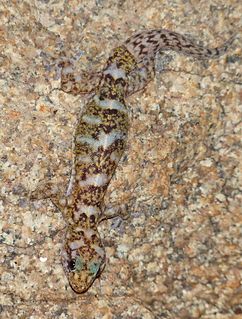
The Sphingidae are a family of moths (Lepidoptera) called sphinx moths, also colloquially known as hawk moths, with many of their caterpillars known as “hornworms”; it includes about 1,450 species. It is best represented in the tropics, but species are found in every region. They are moderate to large in size and are distinguished among moths for their agile and sustained flying ability, similar enough to that of hummingbirds as to be reliably mistaken for them. Their narrow wings and streamlined abdomens are adaptations for rapid flight. The family was named by French zoologist Pierre André Latreille in 1802.

Afroedura is a genus of African geckos, lizards in the family Gekkonidae. Member species are collectively known as rock geckos or flat geckos.
The Cape rock gecko or Hawequa flat gecko is a species of lizard in the family Gekkonidae. The species is endemic to South Africa.

Xanthopan is a monotypic genus of sphinx moth, with Xanthopan morganii, commonly called Morgan's sphinx moth, as its sole species. It is a very large sphinx moth from Southern Africa and Madagascar. Little is known about its biology, though the adults have been found to visit orchids and are one of the main pollinators of several of the Madagascar endemic baobab (Adansonia) species, including the critically endangered Adansonia perrieri or Perrier's baobab.
Vivian Frederick Maynard FitzSimons, born in Pietermaritzburg, was a notable herpetologist in South Africa. Also, he contributed to the collection of spermatophyte samples for the National Herbarium which has become part of the South African National Biodiversity Institute at the Pretoria National Botanical Garden. In 1937, together with Anna Amelia Obermeyer, he collected some of the earliest plant specimens from the Eastern Highlands of Rhodesia.
Afroedura broadleyi, also known commonly as Broadley's rock gecko, is a species of lizard in the family Gekkonidae. The species is endemic to South Africa.
The Amatola rock gecko or Amatola flat gecko is a species of African gecko endemic to South Africa.
Haacke's rock gecko or Haacke's flat gecko is a species of African gecko endemic to South Africa.
Afroedura halli, also known commonly as Hall's flat gecko or the inland rock gecko, is a species of gecko, a lizard in the family Gekkonidae. The species is endemic to South Africa.
Afroedura karroica, also known as the inland rock gecko or Karoo flat gecko, is a species of African gecko found in South Africa and Lesotho.
Afroedura langi, also known as Lang's rock gecko, Lang's flat gecko, or Lowveld flat gecko, is a species of African gecko found in South Africa and Mozambique.
Loveridge's rock gecko is a species of gecko, a lizard in the family Gekkonidae. The species is endemic to southeastern Africa.
Afroedura major, also known as the major rock gecko, Swazi flat gecko, or giant Swazi flat gecko, is a species of African gecko endemic to Eswatini.
Afroedura marleyi, also known as Marley's rock gecko or Marley's flat gecko, is a species of African gecko found in South Africa and Swaziland.
The multipored rock gecko or Woodbush flat gecko is a species of African gecko found in South Africa.
The Namaqua rock gecko or Namaqua flat gecko is a species of African geckos found in South Africa.

The Drakensberg rock gecko, Drakensberg flat gecko, or mountain flat gecko is a species of African gecko found in South Africa and Lesotho.
The Queenstown rock gecko or Tembu flat gecko is a species of African gecko found in South Africa.
Donald George Broadley (1932–2016) was an African herpetologist. He described as new to science 115 species and subspecies, and 8 genera and subgenera of reptiles. He was one of the founders of the Herpetological Association of Africa. He earned his doctorate at the University of Natal in 1966. His widow, Sheila Broadley, is also a herpetologist.




